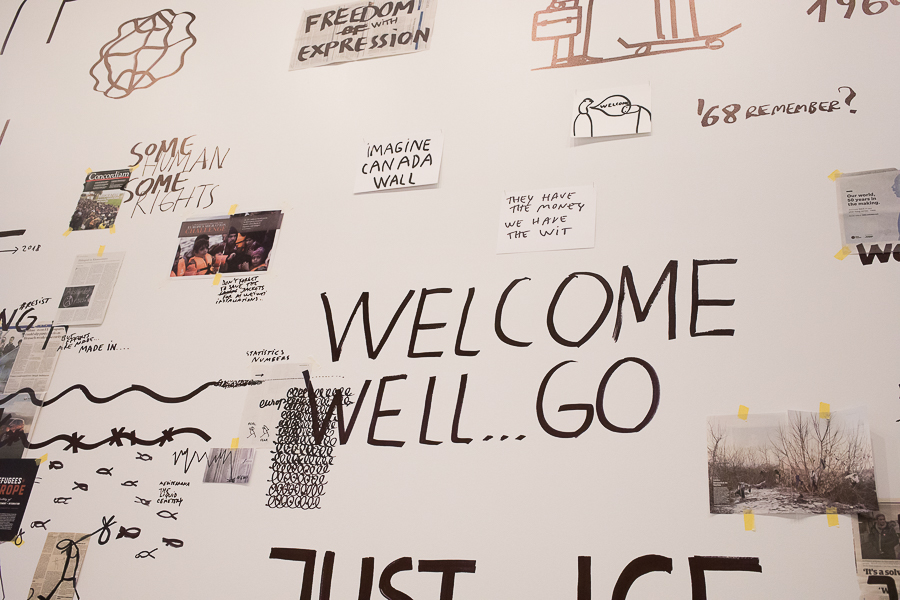
UC Davis art exhibition explores gritty topics like refugee crisis
The Manetti Shrem Museum of Art opened its third exhibition of the year on Thursday Feb 1. Running until June 24, “Welcome?” tackles pertinent issues like immigration and homelessness through the lens of hospitality. In light of the new curation, The California Aggie explored what “Welcome?” has to offer.
When I initially entered the Manetti Shrem, an employee at the door approached and asked if I was here for the Wayne Thiebaud exhibit. The famed artist and former UC Davis professor has a concurrently running exhibition of his own work over a 10-year period, titled “Wayne Thiebaud | 1958–1968.” As innocent as the passing remark may have been, it made me wonder if the “Welcome?” exhibit, a mere two weeks into its allotted time, had been overshadowed and forgotten — much like the topics included in the exhibition.
After navigating my way through the vast quantity of beautiful Thiebaud paintings, I found myself in the back of the museum. The beginning of the exhibition is marked by two gleaming golden mylar emergency blankets, mounted on walls opposite one another.
Beneath each lies an overflowing mound of the same mounted blankets, encased in a plastic bag. Each blanket contains a small sheet of paper adorned with the following quote: “With silent lips. Give me your tired, your poor, Your huddled masses yearning to breathe free, The wretched refuse of your teeming shore.”
Taken from the base of the Statue of Liberty, the words cut straight to the core of the global refugee issue. The whole piece is titled “(America) Adopt a Refugee.” The artist, Daniel Joseph Martinez, appears to not only challenge the United States’ immigration approach, but also to address the fact that our country’s own history stems from immigration.
Further into the exhibit, I found Simon Leung’s “War After War.” The 90-minute film comments on homelessness through the nomadic lifestyle of Leung’s friend, Warren Niesluchowski. The film follows Niesluchowski, who plays the role of a refugee, as he struggles to find a reliable place to stay. The predicament leads Niesluchowski to crash the lives of several individuals who put him up for the night. It demonstrates all of the positives and negatives behind taking a refugee in. While one’s life may gain a newfound individual of interesting background and substance, the fear of allowing a foreigner into our lives remains quite real. This narrative allows Leung to analyze what hospitality entails and how it makes us feel.
Andrea Bowers dominates the last wave of the exhibit. Her massive maize-colored quilts each inscribed with a quote from the Bible are attention-grabbing, to say the least.
“I was a stranger and you welcome me,” reads one of the quilts. The other holds the same message, but in Spanish. The piece, titled “Quilt of Radical Hospitality/Edredon de Hospitalidad Radical,” touches on the fact that, while quilts are European in origin, these quilts are weaved with traditional Mexican patterns. The use of the quilts and European and Mexican interaction recall both the idea of the United States’ “blanket” stance on immigration and the intermingling of American and Mexican cultures.
Bowers follows this up with two pieces: “An Act of Radical Hospitality” and “Mother and Child in Political Sanctuary, Adalberto United Methodist Church, Chicago, IL, July 2007.” The pieces depict the very real immigration story of Elvira Arellano in film and photographs, respectively. The pieces tell the story of a single illegal Mexican mother and her young child. Facing deportation, Arellano is granted federal sanctuary by the Adalberto United Methodist Church and its Reverend Walter Coleman. The story is both sobering and uplifting, stripping away any ambiguity in the art; we are left with nothing but truth and simple questions like, how do we treat people? And how do we welcome them in the modern world?
“Welcome?” is a brash exhibit with big ideas. Aspects of the art seem distant from the core principles of hospitality and welcomeness. However, many of the pieces strike a real chord of emotion, which is a true accomplishment for any art form. Even more so, the art approaches the exhibition’s ideas in both avante garde and simple ways. In this sense, it caters to both sides of the artistic audiences. Much like the issues it’s after, it’s not perfect, and it doesn’t promise to be. And yet, despite the presence of an artistic legend in the same building, “Welcome?” stands tall.
Written by: Rowan O’Connell-Gates — arts@theaggie.org



